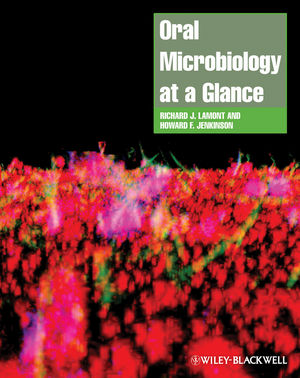Oral Microbiology at a GlanceISBN: 978-0-8138-2892-3
Paperback
96 pages
March 2010, Wiley-Blackwell
 This is a Print-on-Demand title. It will be printed specifically to fill your order. Please allow an additional 10-15 days delivery time. The book is not returnable.
|
||||||
Preface ix
Chapter 1 Introduction to oral microbiology 2
Commensals and pathogens
Oral diseases
Chapter 2 In the beginning 4
The first microbes
Microbial basis of infectious disease
Miller and the chemoparasitic theory of caries
Oral and dental research
Chapter 3 Caries as an infectious disease 6
Dental caries as a transmissible disease
Streptococcus mutans
Mutans group streptococci
Link between S. mutans and dental caries
Immunity to caries
Chapter 4 General properties of saliva 8
Saliva production
Protective role of saliva
Salivary pellicle
Saliva as a nutrient
Chapter 5 Salivary mucins and agglutinins 10
Composition of mucins
Properties of mucins
Bacterial agglutination
Chapter 6 Secretory Immunoglobulin A 12
Production of S-IgA
Functions of S-IgA
Inactivation of salivary defenses
Development of S-IgA
The window of infectivity
Selective IgA deficiency
Chapter 7 Anti-microbial properties of saliva 14
Anti-microbial components in saliva
Chapter 8 Innate defenses 16
Anti-microbial peptides (AMPs)
Human AMPs
Chapter 9 Microbes in the oral cavity 18
Primary colonizers
Beneficial effects of bacterial colonizers
Ecological plaque hypothesis
Ecology and disease
Chapter 10 Molecular microbial taxonomy 20
Molecular taxonomy
Denaturing gradient gel electrophoresis
DNA chips
Chapter 11 Systems approaches to oral microbiology 22
Transcriptomics
Proteomics
Gene ontology
Post-translational networks
Tiled arrays
Chapter 12 Oral streptococci 24
The genus Streptococcus
Viridans streptococci
Lancefield grouping
Relatedness and pathogenicity of streptococci
Chapter 13 Microbial adherence 26
Adherence
Long-range adherence
Specific adhesion
Oral bacterial adhesins and receptors
Chapter 14 Complex communities 28
Inter-microbial reactions
Co-adhesion
Metabolic associations
Antagonism
Chapter 15 Biofilms 30
Biofilm development
Microbial recognition of surfaces and interbacterial communication
The biofilm matrix, resilience and resistance
Chapter 16 Bacterial polysaccharides 32
Extracellular polysaccharide production
Glycosyltransferases and fructosyltransferases
Glucan binding proteins
EPS produced by oral Gram-negatives
Chapter 17 Microbiology of caries 34
Structure of teeth
Dental caries
Types of dental caries
Important bacteria in caries
Emerging and polymicrobial pathogens
Chapter 18 Virulence factors of S. mutans 36
Initial attachment to tooth surfaces
Polysaccharide production
Acid production
Acid tolerance
Biofilm adaptation
Chapter 19 Host and environmental factors in caries 38
Host factors
Dietary factors
Caries risk assessment
Chapter 20 Fluoride 40
Modes of action of fluoride
Strategies for fluoride delivery
Anti-microbial effects of fluoride
Enhancing anti-microbial effects
Chapter 21 Anti-caries strategies 42
Inhibitors
Probiotics
Immunization
Vaccination
Chapter 22 Periodontal diseases 44
Classification of periodontal diseases
Role of plaque bacteria in periodontal diseases
Role of host factors in periodontal diseases
Chapter 23 Microorganisms associated with periodontal diseases 46
Gingivitis
Chronic periodontitis
Localized aggressive periodontitis
Generalized aggressive periodontitis
Color-coded complexes
P. gingivalis, a consensus pathogen
A. actinomycetemcomitans, a pathogen in LAP
Culture independent bacterial detection
Chapter 24 Colonization by periodontal bacteria
Adhesion
Periodontal bacterial adhesins
Intracellular invasion
Mechanisms of invasion
Host responses to intracellular bacteria
Chapter 25 Virulence factors of periodontal bacteria 50
Toxins
Proteolytic enzymes
Bacterial components that impact alveolar bone
Other toxic products
Chapter 26 The immune response and periodontal bacteria 52
Importance of neutrophils
Innate immune sensing of periodontal bacteria
Tissue destruction and bone loss
Genetic factors associated with periodontal disease
Chapter 27 Relationship between periodontal diseases and systemic health 54
Pathogenic mechanisms – general principles
Cardiovascular disease (CVD)
Adverse pregnancy outcomes
Pulmonary infections
Diabetes
Osteoporosis
Chapter 28 Implants and titanium 56
Osseo-integration
Implant structure
Peri-implantitis
Bacteria associated with peri-implantitis
Asepsis and treatment
Chapter 29 Endodontic infections 58
Dentinal tubules
Bacterial invasion of dentin
Microbiota of endodontic infections
Symptomatic versus asymptomatic
Treatment
Chapter 30 Host factors in endodontic infections
Pulpal infections
Periapical abscesses
Repair and angiogenesis
Resistant bacteria
Chapter 31 Infective endocarditis 62
Bacteria in IE
Mechanism of vegetation formation
Bacterial virulence factors
Antibiotics in IE
Chapter 32 Oral mucosal, bone and systemic infections 64
Mucosal infections
Submucosal and bone infections
Oral manifestations of systemic infections
Systemic manifestations of oral infections
Chapter 33 Candida albicans and fungal infections 66
C. albicans infections
Denture stomatitis
Angular cheilitis
Gingivitis and periodontal disease
Prosthetic implants
Biofilms and antifungal drugs
Chapter 34 Oral virology I, herpes, papillomavirus and parvovirus 68
Herpes viruses
Papillomaviruses
Parvoviruses
Chapter 35 Oral virology II, hepatitis and HIV
Hepatitis B virus (HBV)
Hepatitis D virus (HDV, delta agent)
Other hepatitis viruses
Human immunodeficiency virus (HIV)
Chapter 36 Antibiotics and antibiotic resistance 72
Antibiotics in dentistry
Resistance to anti-microbial agents
Transfer of anti-microbial resistance
Curtailing anti-microbial resistance
Chapter 37 Sterilization 74
Heat
Radiation
Chemicals
Chapter 38 Disinfection 76
Physical
Chemical
Chapter 39 Infection control 78
Prions
Dental unit water lines (DUWL)
Chapter 40 Bioterrorism 80
Anthrax
Botulism
Smallpox
Salmonella
Biological Weapons Convention
Index 83



